
By Kasey Cantwell, Expedition Coordinator - NOAA Office of Ocean Exploration and Research
May 6, 2017
A highlight of Dive 05 at Jarvis Island was observing a group of ophiuroids capture and eat a squid (Abralia sp.) that was swimming by. Our science team was shocked to see this behavior from a brittlestar. This interaction helps us understand a little bit more about bentho-pelagic coupling in this region. Video courtesy of the NOAA Office of Ocean Exploration and Research, Mountains in the Deep: Exploring the Central Pacific Basin. Download larger version (mp4, 1.8 MB).
To quote one of our shore-based scientists, "this is the most fantastic thing I have ever seen!" Yesterday's dive was phenomenal. During Dive 05, we investigated a ridge off the southeast side of Jarvis Island. As we transited upslope, the ridge had high biodiversity, with several small- to medium-sized high-density communities of different organisms. As we entered each new depth range, we found a new high-density community. Seeing one high-density community is usually something to get excited about, but seeing six? That is exceptionally rare and truly amazing.
High-density communities observed included a couple anchored by different types of deep-sea corals; multiple instances of stands of crinoids, urchins, holothurians, and ophiuroids; an expansive landscape of polychaete thickets; and a stretch of hundreds, if not thousands, of primnoid colonies.
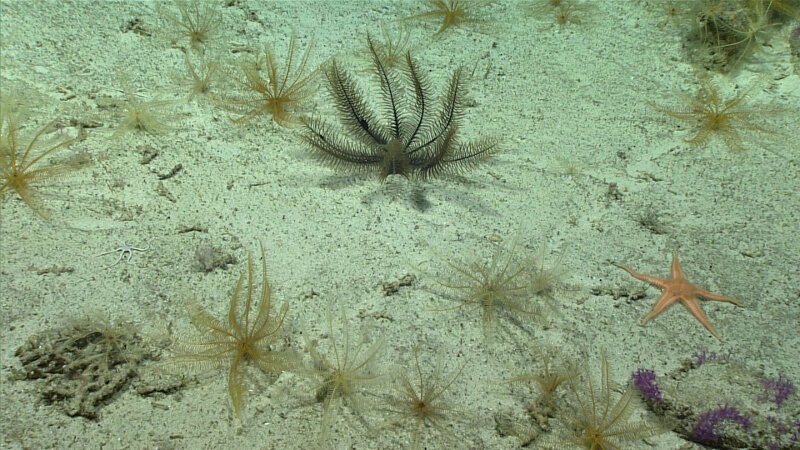
Crinoids were very common throughout Dive 05, and they were often found in high densities, as is shown here. Image courtesy of the NOAA Office of Ocean Exploration and Research, Mountains in the Deep: Exploring the Central Pacific Basin. Download larger version (jpg, 1.7 MB).
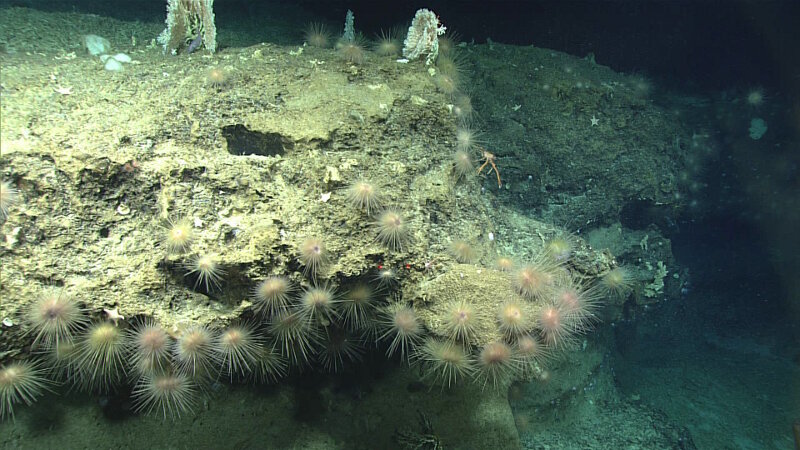
Throughout the dive at Jarvis Island, echinoderms were common under almost every overhang. Here, a vagrant (or large group) of urchins have covered this overhang. Image courtesy of the NOAA Office of Ocean Exploration and Research, Mountains in the Deep: Exploring the Central Pacific Basin. Download larger version (jpg, 1.5 MB).
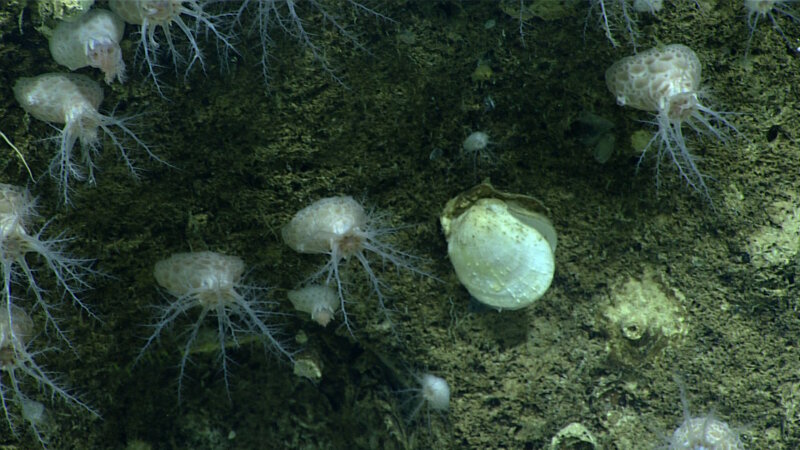
While they may look like anemones, believe it or not, these are holothurians! Several of our science team had never seen this type of sea cucumber, so it was an interesting discovery to find several boulders covered in them. Image courtesy of the NOAA Office of Ocean Exploration and Research, Mountains in the Deep: Exploring the Central Pacific Basin. Download larger version (jpg, 1.3 MB).
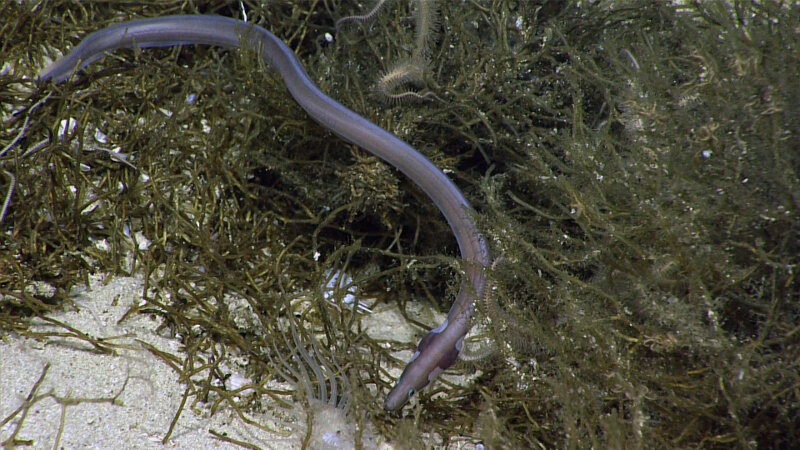
A snake eel in a thicket of polychaete worms. These polychaetes have built large worm tubes and were found in a high density for a portion of our dive at Jarvis Island. Image courtesy of the NOAA Office of Ocean Exploration and Research, Mountains in the Deep: Exploring the Central Pacific Basin. Download larger version (jpg, 1.8 MB).
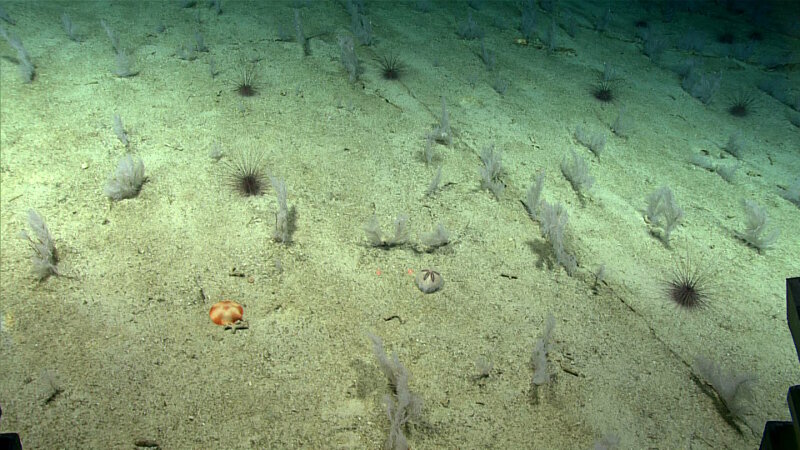
For a distance of about 100 meters during our dive at Jarvis Island, as far as remotely operated vehicle Deep Discoverer's light pool reached, the bottom was covered in primnoid corals and sea urchins. Image courtesy of the NOAA Office of Ocean Exploration and Research, Mountains in the Deep: Exploring the Central Pacific Basin. Download larger version (jpg, 1.6 MB).
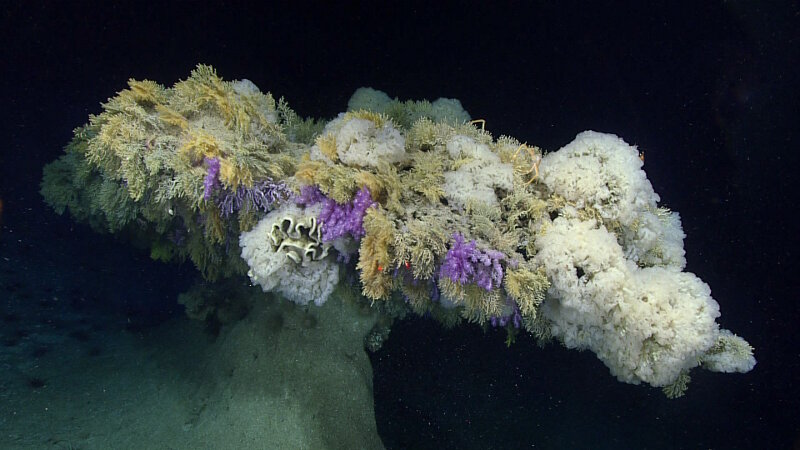
One of the most exciting observations of the dive was this unusual umbrella-shaped pillar feature covered in deep-sea corals and sponges. Image courtesy of the NOAA Office of Ocean Exploration and Research, Mountains in the Deep: Exploring the Central Pacific Basin. Download larger version (jpg, 1.3 MB).
Not all of our interesting observations were of high-density communities; we also documented several unusual animals, as well as common animals behaving in rarely seen ways.
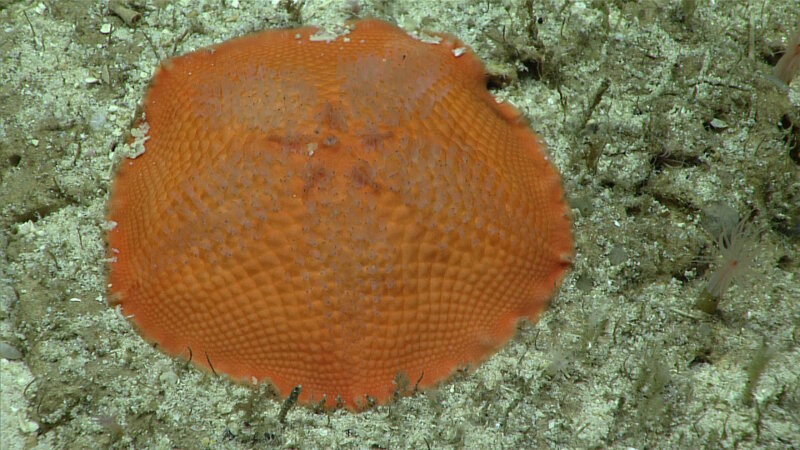
An unusual seastar with no arms (likely Tremaster mirabilis)– we saw several of these as we climbed upslope during Dive 05. Image courtesy of the NOAA Office of Ocean Exploration and Research, Mountains in the Deep: Exploring the Central Pacific Basin. Download larger version (jpg, 1.5 MB).
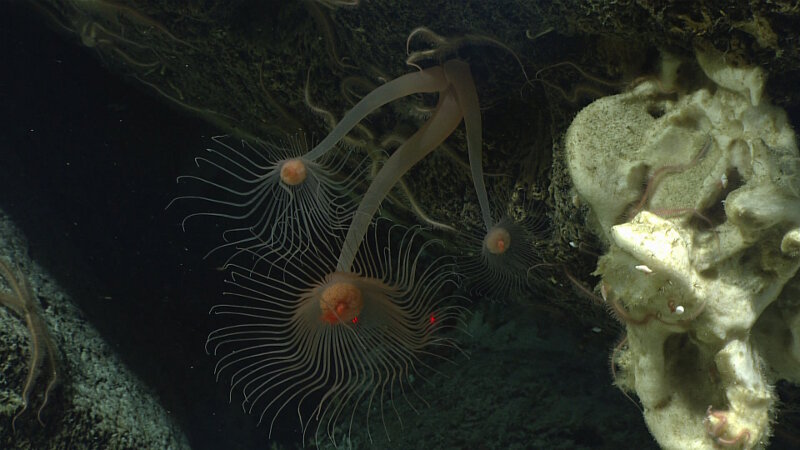
Solitary hydroids are fairly common observations during NOAA Ship Okeanos Explorer dives, but there was much discussion amongst our science team as to why these three individuals appear to share a base. Image courtesy of the NOAA Office of Ocean Exploration and Research, Mountains in the Deep: Exploring the Central Pacific Basin. Download larger version (jpg, 953 KB).

This pelagic holothurian is typically seen in the water column, but we saw several on the seafloor, seemingly snagged on the coral rubble. Image courtesy of the NOAA Office of Ocean Exploration and Research, Mountains in the Deep: Exploring the Central Pacific Basin. Download larger version (jpg, 1.5 MB).
The excitement wasn't just limited to the benthic life either. We saw several different fish species, a shark, and then ended the dive with a school of Randall's snappers, lurking just outside of Deep Discoverer's light pool.
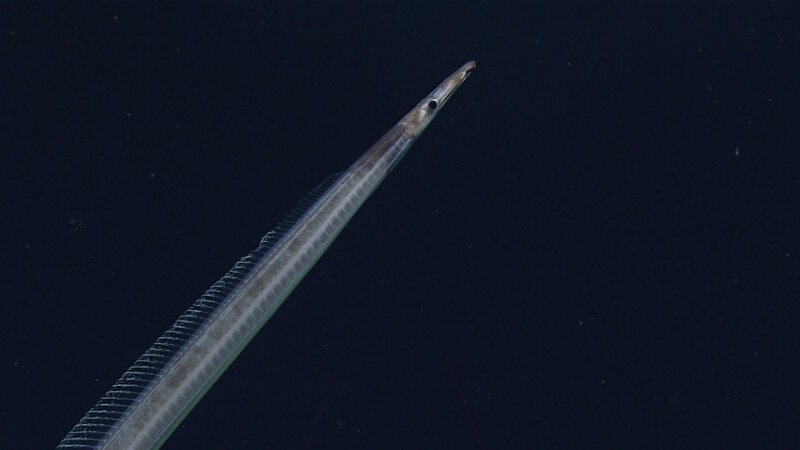
A duckbill eel was observed early in our dive on Jarvis Island. Image courtesy of the NOAA Office of Ocean Exploration and Research, Mountains in the Deep: Exploring the Central Pacific Basin. Download larger version (jpg, 610 KB).
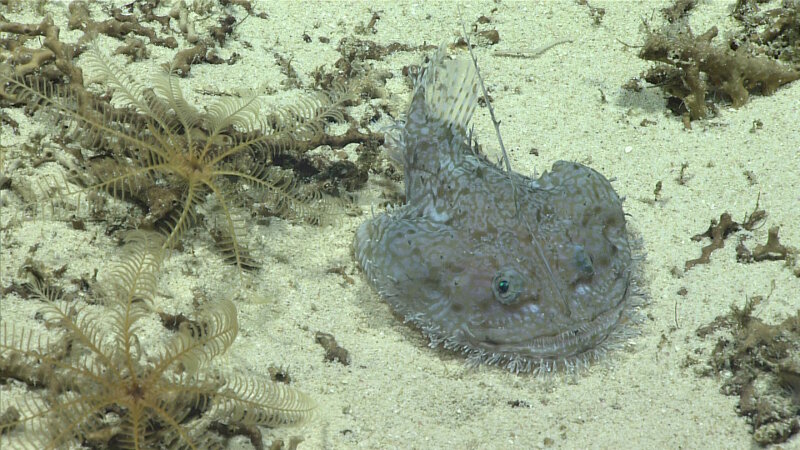
We observed goosefish, like the one pictured here, at a variety of depths throughout our dive at Jarvis Island. Image courtesy of the NOAA Office of Ocean Exploration and Research, Mountains in the Deep: Exploring the Central Pacific Basin. Download larger version (jpg, 1.5 MB).
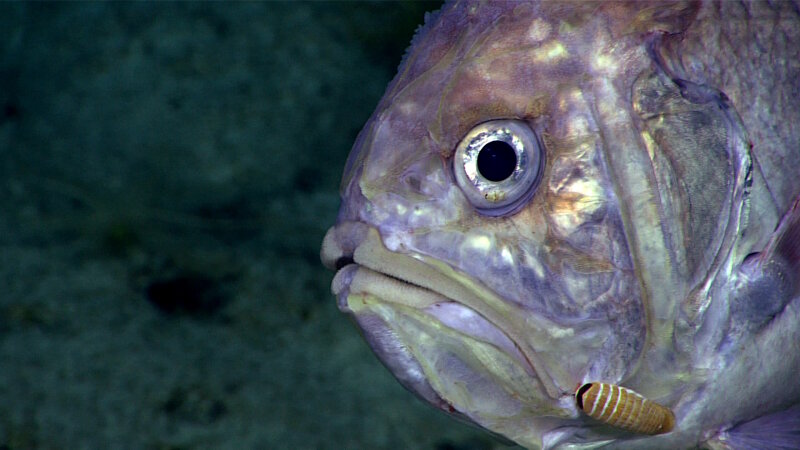
Roughy with an isopod parasite. Prior to 2005, roughies were not known to exist in this region. Since then, expeditions conducted as part of the Campaign to Address the Pacific monument Science, Technology, and Ocean NEeds (CAPSTONE) have been greatly expanding the known distribution of roughy with observations in nearly every major CAPSTONE operating area. Image courtesy of the NOAA Office of Ocean Exploration and Research, Mountains in the Deep: Exploring the Central Pacific Basin. Download larger version (jpg, 1.3 MB).
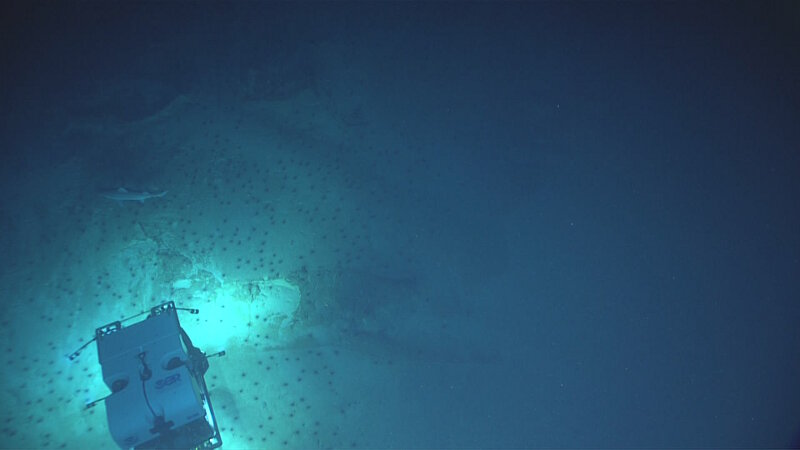
Sharks are always fun to observe. Here, ROV Deep Discoverer is pictured with a sand tiger shark. The "black dots" on the seafloor are all sea urchins, another high-density community observed during Dive 05. Image courtesy of the NOAA Office of Ocean Exploration and Research, Mountains in the Deep: Exploring the Central Pacific Basin. Download larger version (jpg, 410 KB).
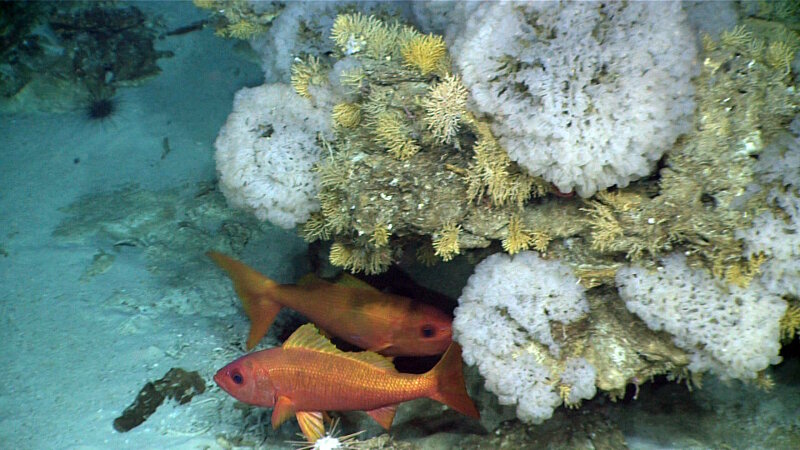
Two of the school of +20 Randall's snappers hang out under an overhang covered in coral and sponges. Image courtesy of the NOAA Office of Ocean Exploration and Research, Mountains in the Deep: Exploring the Central Pacific Basin. Download larger version (jpg, 1.8 MB).
Our observations of the deep sea are relatively few, and there are still many places in our ocean that have never been seen by humans. Since we typically only get to see a snapshot of a community, it is particularly exciting when we are able to observe in situ behaviors or life history events – like predation or breeding. This helps us better understand how an organism lives its life versus just knowing that they exist in a given location.

This golden crab, seen under a rock overhang during the dive at Jarvis Island, is carrying a large egg mass under her abdomen. Image courtesy of the NOAA Office of Ocean Exploration and Research, Mountains in the Deep: Exploring the Central Pacific Basin. Download larger version (jpg, 1.3 MB).